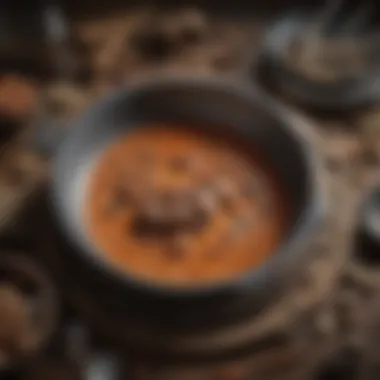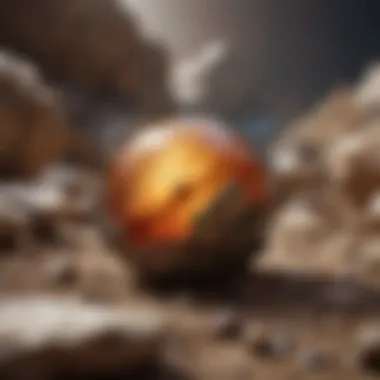Unlocking the Secrets of the Prospecting Pan


Intro
Exploration of the Earth’s crust yields treasures beyond what is visible at first glance. Among these wonders lies the prospecting pan, an indispensable tool for both novice and seasoned collectors. Whether you’re hunting for glittering gold flakes or the remnants of ancient life, mastering the use of a prospecting pan opens the door to myriad geological discoveries. This guide dives into the essentials of using this remarkable instrument with a keen focus on rock and fossil identification, collecting techniques, preservation methods, and profound geological insights.
Rock and Fossil Identification
Identifying rocks and fossils is a fundamental step in the collecting journey. An accurate grasp of their types and characteristics can significantly elevate your exploration experience.
Types of Rocks and Fossils
There are three primary types of rocks: igneous, sedimentary, and metamorphic. Each type offers various clues about the Earth's history and the conditions under which they formed. Fossils, on the other hand, are the vestiges of once-living organisms, often preserved in sedimentary rocks.
- Igneous rocks: These form from cooled magma or lava. Look for textures that indicate cooling rates, such as coarse-grained textures in Granite or smooth appearances in Obsidian.
- Sedimentary rocks: These rocks usually contain fossils and form through the accumulation of sediment. They can often be identified by their layering and the presence of grains or shell fragments.
- Metamorphic rocks: Resulting from changes in temperature and pressure, these rocks may show banding patterns or a shiny appearance.
When it comes to fossils, familiar types include ammonites, trilobites, and various plant fossils. Fossils will often have specific features, such as detailed impressions or unique shapes, helping to identify their type.
Characteristics to Look For
When identifying rocks and fossils, certain characteristics become significant:
- Color: The coloration can offer hints about mineral content. Metallic lusters in rocks may indicate ores.
- Texture: Rough, smooth, or layered qualities can be clues to their formation.
- Weight: Heavier specimens might suggest denser materials, which can guide to further exploration.
Tools for Identification
To aid in identification, a few handy tools can be beneficial:
- Hand lens: Useful for examining small details and textures.
- Rock hammer: Essential for breaking open rocks to reveal internal features.
- Field guidebooks: Reference materials serve as a valuable asset in proper identification.
Prologue to Prospecting Pans
The concept of prospecting pans is not just a mere relic of geological exploration; they are, in fact, the backbone of any enthusiast's toolkit. As one embarks on a quest for hidden gems—be it mineral deposits or fossilized remains—understanding the ins and outs of prospecting pans is crucial. These unassuming tools facilitate the separation of valuable materials from sediment and soil, making them indispensable in the field.
Definition and Purpose
A prospecting pan is primarily designed for the process of panning, which involves washing, swirling, and sifting through dirt and gravel to isolate precious minerals. The purpose is straightforward: it allows the user to find and collect materials that are often concealed beneath layers of earth. Whether one is in a stream bed, riverbank, or a designated digging site, the pan serves as a reliable aid in uncovering geological treasures.
Moreover, the design of prospecting pans varies widely, reflecting their intended function. Standard pans are generally shallow with a wide rim, allowing for easier shaking and tilting. In contrast, specialized pans might include ridges or textured surfaces for enhanced efficiency. Each design element aims to optimize the panning process, helping collectors find what they seek more effectively.
Historical Context
Prospecting pans have a rich history that dates back to ancient gold rushes, where hopeful prospectors sought their fortunes in riverbeds. Notably, during the California Gold Rush of the mid-1800s, panning became a popular nearly universal method for sifting through sediments. The simple yet effective technology has remained relevant throughout the ages, evolving with new materials and designs that cater to modern collectors.
A historical glance reveals that these tools were not limited to gold mining. In many cultures, including those native to the Americas, pans were employed for various purposes, from extracting valuable pigments to finding usable stones.
In contemporary times, as geological interest has surged, especially among amateur collectors, the prospecting pan has regained popularity. In addition to gold and minerals, fossil collectors often use them to sift through soil for ancient relics, underscoring the versatility of this essential tool.
"The true value of a prospecting pan lies not merely in its function, but in the stories and discoveries it helps unearth."
Understanding the introduction and fundamentals of prospecting pans equips collectors with a greater appreciation for their craft. Grasping their definition and historical significance can serve as stepping stones for engaging more deeply in geological pursuits. Hence, embracing these tools is not only beneficial but essential to those who wish to accumulate knowledge and prizes from the earth.
Types of Prospecting Pans
When it comes to collecting geological specimens, having the right tools makes all the difference. Prospecting pans aren't just random gadgets; they come in various styles tailored for particular purposes. Understanding these types of prospecting pans helps collectors choose the best one suited to their needs and objectives. Each type offers unique benefits and applications, turning the simple act of panning into a refined technique.
Standard Pans
Standard pans are the workhorses of the collecting world. Typically, these pans are designed with a flat bottom and gentle sloping sides, making them ideal for beginners. Their lightweight construction means they can be easily transported to any site. These pans come in various diameters, generally between 10 to 16 inches. One of their key features includes textured bottoms, which help in trapping heavier materials like gold or other minerals during the washing process.


Standard pans are not too fussy, either. They're often made of plastic, making them more affordable. Using a standard pan does not require any previous expertise, allowing collectors to dive in right away. This ease of use remains one of its strongest selling points.
Specialized Pans
Not all collectors are chasing the same kind of prize. Specialized pans cater to specific needs, enhancing the prospecting experience significantly. Three particular types of specialized pans stand out: Gold pans, Mineral pans, and Fossil pans.
Gold Pans
When thinking about gold pans, what comes to mind is the classic image of a prospector in a stream, trying to catch a glimmer of gold. Gold pans usually feature a distinct shape, typically wider and shallower compared to standard pans. This design enhances their effectiveness, too. The wider surface area allows for better water flow and more efficient separation of materials.
A unique characteristic of gold pans is their color – many are manufactured in black or green. This is not just for aesthetics; darker colors enhance the visibility of gold flakes, making them easier to spot amidst the debris. Collectors often find these pans beneficial because they give a better sense of the material being processed, increasing the chances of finding valuable nuggets or flakes that might otherwise be lost.
Mineral Pans
Mineral pans serve a specific purpose, aimed at collectors interested in various minerals beyond just gold. These pans often come equipped with specialized riffles designed to catch heavier minerals while letting lighter materials wash away.
Collectors appreciate mineral pans for their versatility. They can be used in different environments, making them a favorite among mineral hunters who want to explore creek beds or cliff faces for trace minerals. However, they do require a bit more technique to use effectively, as collectors have to learn how to maximize the potential of the pan’s design.
Fossil Pans
Fossil pans mark a unique niche in the prospecting world. They usually sport a flat bottom and wider opening at the top. This design enables collectors to gently sift through sediments, maximizing the chances of spotting fossils without damaging them.
What makes fossil pans particularly popular is their gentle touch. Fossils, especially fragile ones, require a careful hand. The open design allows one to explore sediment with minimal disruption, optimizing the search for that prized specimen. Though they may not catch as many minerals as other pans, individuals focused specifically on paleontology often find this tool invaluable.
Materials and Their Impact
Every collector should recognize that the material of the prospecting pan significantly impacts performance. Pans can be made from plastics or metals, and each has its share of advantages and disadvantages that collectors must consider carefully.
Plastic vs. Metal
Plastic pans are lightweight and easy to handle, making them a great entry-level option. They're also less expensive than metal alternatives. However, metal pans offer superior durability and can withstand harsher conditions without cracking or breaking. Yet, they can be heavier, which might discourage some collectors from lugging them on long treks. Choosing between plastic and metal depends on personal preference and specific use cases.
Weight Considerations
When considering weight, think about your intended use. A heavier pan means added effort during hikes or treks. Conversely, lighter plastic pans may be easier to carry but can compromise durability. Having a balance is key, especially when out in the field for extended periods.
Durability
Durability matters quite a bit, especially for serious collectors. Metal pans often win here, as they can resist impacts and punctures better than plastic. Nonetheless, one could argue the convenience of a plastic pan in calmer, less rugged settings outweighs its fragility. Collectors are encouraged to assess the terrain where they will do most of their prospecting before making a decision.
"Your choice of a prospecting pan can greatly influence your success on the field; choose wisely."
Using a Prospecting Pan Effectively
Using a prospecting pan effectively is not just about having the tool; it's a blend of strategy and method that can greatly influence the success of your geological endeavors. Realizing its potential can turn an average panning session into a fruitful hunt for treasures. Hence, understanding the intricacies of preparation, techniques, and avoiding pitfalls can enhance a collector’s experience immensely.
Preparation Steps
Choosing the Right Location
The adage "location, location, location" rings true in the world of prospecting. Choosing the right spot can be a game changer. A good location ensures the presence of valuable minerals and fossils, which is exactly what every collector aspires to find. An ideal site often borders creeks or areas with recent geological movements, as these places show evidence of sediment displacement.
A key characteristic of a prime prospecting location is its geological history. Places known for their past mining activities or rich fossil beds are usually gold mines—literally and figuratively. However, not every sought-after site is easily accessible or allowed for mining, so one must always do their due diligence to check local laws. The unique feature of these locations is the concentration of materials, meaning the chances of hitting the jackpot are greater. Yet, poor planning can lead many into inaccessible areas or even private properties, which can spell disaster for a collector.
Gathering Essential Tools
The right tools can spell success or failure in prospecting. Think of your tools as the sidekicks to your hero’s journey. Besides the prospecting pan itself, essential tools might include a shovel, sieve, and a sturdy backpack to carry your finds. Having these in hand not only contributes to efficiency but also ensures you are prepared for any situation while out in the field.
One major benefit of gathering these tools ahead of time is preparedness. If you find that perfect spot but are missing a tool, the whole day's effort might go to waste. The unique feature here is that a well-prepared collector can adapt to various situations, whether it’s needing to dig deeper to find fossils or effectively separate minerals. However, overpacking can weigh one down; it's essential to find a balance.


Panning Techniques
Basic Technique
The basic technique of panning involves understanding the process of separation. It’s fairly straightforward, yet demands practice. You fill your pan with sediment and shake it back and forth in water at an angle. This method works on the principle that heavier materials like gold sink to the bottom, whereas lighter sands wash away.
A benefit of mastering this technique is that it acts as the foundation for all other methods. As simple as it sounds, getting this part right is crucial. The unique feature of the basic technique lies in its adaptability. Once you are comfortable, you can adjust your motions based on the materials you’re working with. However, rushing this process may lead to overlooking valuable materials.
Advanced Techniques
Branching into advanced techniques offers the opportunity to refine your skills further. Techniques like "water panning" or the use of a sluice box leverage water flow to wash away lighter materials while retaining heavier ones. These methods are particularly useful in areas where sediment is abundant.
The primary advantage of advanced techniques is efficiency. Collectors can process larger amounts of material in shorter spans of time. The unique feature of these methods is that they introduce a level of sophistication that can significantly enhance the yield of your efforts. Yet, they often require more gear and sometimes a learning curve—making them less accessible for complete novices.
Optimizing Your Approach
Optimizing your approach can mean tweaking your strategy based on your observations. It’s about using your environment and the tools at your disposal effectively. Taking note of shifting currents, local geology, and even other collectors' outcomes can inform your methods.
A key characteristic of optimizing is the adaptability. It allows you to pivot quickly, responding to the conditions surrounding you. This approach ensures you're not just following standard practices but rather developing a personalized strategy that plays to your strengths. The challenge lies in continuously evaluating what works and what doesn’t, especially since each panning session can differ dramatically.
Common Mistakes to Avoid
Common pitfalls can lead to wasted time and frustration. Here are a few to keep a watchful eye on:
- Neglecting Location Research: Not all sites are equal; being ill-informed can send you to barren grounds.
- Overpacking: Ease of movement can be crucial, especially when navigating tough terrains. Stick to what’s necessary.
- Ignoring Weather Conditions: Sudden changes can turn a pleasant outing into a hazardous situation. Always check forecasts.
By avoiding these mistakes, collectors can truly maximize their experience. Each misstep presents an opportunity to learn, turning every session into a step toward expertise.
Maintenance of the Prospecting Pan
Maintaining a prospecting pan is not merely a task, but a pivotal aspect of ensuring its longevity and effectiveness. For both novice and seasoned collectors, understanding how to keep this essential tool in top shape can significantly enhance the prospecting experience. A well-cared-for pan can improve efficiency during fieldwork and ensure accurate results when searching for geological and fossil treasures. Ignoring maintenance, however, may lead to frustrations and missed opportunities.
Cleaning Techniques
Cleaning techniques for a prospecting pan are paramount in retaining its functionality. It isn’t just about removing dirt; it’s about ensuring that each session is as fruitful as possible. Here, we delve into two critical aspects of cleaning: Post-Use Cleaning and Preventative Maintenance.
Post-Use Cleaning
After a day spent sifting through streams or rocky outcrops, a thorough post-use cleaning of your prospecting pan cannot be overstated. This practice is key for removing residual materials, which can otherwise interfere with future panning sessions. A distinctive characteristic of post-use cleaning is its straightforward approach, often requiring just water and a soft scrub brush. By rinsing and gently brushing away materials, you not only clean the pan but also prolong its lifespan.
One major advantage of this cleaning method is the ability to reset the pan for its next use. By ensuring no debris or traces of previous materials are left behind, you prevent cross-contamination that could skew results during panning. However, collectors should be cautious of using harsh chemicals, as they can degrade the materials of the pan, especially if it’s plastic.
"Regular cleaning increases efficiency and enhances the results from your prospecting efforts."
Preventative Maintenance
Preventative maintenance takes a proactive stance towards care, which is essential for the longevity of your pan. This involves routine checks and simple practices that prevent major issues down the line. For example, checking for cracks or warping before heading out can save you a lot of trouble in the field.
The key characteristic of preventative maintenance lies in its holistic approach. Collectors who frequently maintain their pans often enjoy fewer disruptions during outings. Regular inspections are invaluable; they can help spot signs of wear early and act accordingly, replacing parts or the pan itself if necessary. The main advantage here is enhanced reliability, knowing your tool is ready for action.
However, one might find it easy to overlook these practices, especially in the midst of excitement before a prospecting trip. Skipping this step can lead to unexpected surprises when it’s time to hit the field.
Storage Recommendations
Proper storage of your prospecting pan is essential. Once the cleaning is done, it is crucial to store it in a way that prevents warping and scratches. Ideally, keep your pans in a dry space, away from direct sunlight to avoid any damage. Using a dedicated storage bag or case can be beneficial, providing protection from dust and impacts. It ensures each pan retains its integrity, ready for its next adventure. Moreover, keeping them organized helps collectors make quick choices based on specific needs for different geological outings, enhancing the overall experience.
Safety Considerations


When it comes to using a prospecting pan, safety is paramount. The thrill of uncovering geological treasures can sometimes overshadow the prudent measures that one should consider when in the field. Not adhering to safety guidelines can lead to accidents or even health hazards. This section not only discusses essential safety considerations but also emphasizes the importance of being aware of one’s surroundings and utilizing proper protective gear.
Working in the Field
Environmental Awareness
One of the most crucial aspects of environmental awareness is understanding the impact our actions have on the ecosystem. When prospecting, it is vital to respect nature and follow responsible practices. Collectors should be mindful of the area's sensitivity, such as avoiding disturbing plant life and wildlife habitats.
Being aware of the environment fosters a more sustainable approach to prospecting. A key characteristic here is the ability to balance enthusiasm for collection with the recognition of ecological preservation. Such awareness is especially beneficial in areas known for endangered species or delicate landscapes.
The unique feature of environmental awareness is its promotion of a sustainable mindset. By prioritizing this awareness, collectors not only enhance their experience but also contribute positively to the geological community at large. However, ignoring this aspect can lead to degradation of environments that future generations might wish to explore.
Personal Protective Equipment
Moving on to personal protective equipment (PPE), it plays an undeniably critical role in ensuring the safety of prospectors. Whether you are sifting through gravel or navigating rocky terrains, having the right gear can prevent injuries. The fundamental characteristic of PPE is that it acts as a barrier between the individual and potential hazards present in the field.
Using PPE, such as gloves, safety goggles, and durable footwear, can dramatically reduce the risk of injuries from sharp rocks or unexpected debris. Its popularity in the community stems from this robust protection it offers. The unique aspect of personal protective equipment is its adaptability; it can be tailored to fit the specific needs of the environment or task at hand.
While PPE greatly increases safety, it may sometimes come with drawbacks, such as restricting mobility or causing discomfort in extreme weather. Nonetheless, these concerns are minor in light of the significant protection it provides, underscoring the importance of its use for every collector.
Health Regulations
Adhering to health regulations is another cornerstone of safe prospecting. This encompasses multiple facets, including understanding the legalities associated with collecting in certain areas. Familiarity with local laws ensures that you do not inadvertently trespass or collect in protected sites.
In addition, staying educated about potential health risks, such as exposure to certain minerals or environmental toxins, is crucial. This knowledge empowers collectors to pursue their hobby safely and responsibly, minimising any adverse health implications. Moreover, staying informed about health regulations reinforces the integrity of the geological community as a whole.
In the end, safety is not merely an add-on to the prospecting process; it is integral to it. By incorporating environmental awareness, utilizing personal protective equipment, and adhering to health regulations, collectors set the stage for a fulfilling and safe mining experience.
The Role of Prospecting Pans in Geological Research
Prospecting pans play an often understated but crucial role in geological research. These simple yet effective tools are not just for gold hunters or casual rock collectors. They serve as fundamental instruments for scientists and researchers who aspire to gather data on Earth’s composition, mineral deposits, and fossil distribution. Understanding their significance can elevate how we view the globe’s wonders and our ability to investigate them deeper.
Data Collection
When it comes to geological research, data is king. The prospecting pan enables researchers to sift through sediment in a structured manner, collecting samples that reveal a wealth of information. Through careful collection, one can analyze the types and proportions of minerals found in a certain area. This, in turn, helps in identifying potential mining sites or researching geological history.
- Sediment Analysis: The pan allows for particular attention to sediment layers, giving geologists insights into historical events, such as volcanic eruptions or glacier movements.
- Sample Diversity: By taking samples from various locations, researchers can build a comprehensive profile of mineral distribution, useful in studies that explore the Earth's geological processes.
- Field Applications: When working in the field, researchers can utilize the pan to quickly assess locations for further investigation. This is especially handy in remote areas where traditional methods may falter.
To illustrate, consider a research team studying the mineral composition of a riverbed. Using prospecting pans, they can gather samples from different spots along the flow, leading to a better understanding of how minerals alter with the flow of water. This hands-on approach is invaluable, creating a narrative about the area that would otherwise go unnoticed.
Environmental Impact Studies
Using prospecting pans isn't solely about uncovering what lies beneath the surface; it also has significant implications for studying the environment. As the world grapples with concerns over climate change, pollution, and ecosystem degradation, these pans can help analyze how natural and human activities impact geological structures and ecological systems.
- Baseline Data: Prospecting pans can capture baseline data before starting any major environmental studies. This prior data can be crucial in determining the extent of change over time.
- Pollution Analysis: In areas where industrial waste might seep into the ground, researchers can use pans to detect trace minerals or heavy metals. These findings could guide regulations or cleanup efforts, showcasing the pan's utility beyond scientific curiosity.
- Habitat Assessment: Understanding the geology of an area is key in assessing habitats for various species. By studying sediment and mineral distribution, researchers can infer the health of ecosystems and make informed conservation decisions.
"New discoveries in geological research often spring from the simplest tools—like the prospecting pan—bridging our ancient past to present concerns over ecological health."
Both aspects highlighted, data collection and environmental studies, illustrate the multifaceted role of prospecting pans in geological research. They go beyond mere instruments for hobbyists and become pivotal in addressing a range of scientific inquiries. As researchers embrace these tools, the value they bring to local and global understanding continues to grow.
Epilogue
In the exploration of prospecting pans, one realizes their significance transcends mere utility. They embody the intersection of passion, science, and discovery for both geology enthusiasts and fossil collectors. As we look to the future of these indispensable tools, it is essential to recognize not only their practical uses but also their evolving role in research and environmental stewardship.
A well-crafted prospecting pan continues to be pivotal in unearthing geological wonders. Advances in materials and design enhance their effectiveness, making them accessible to hobbyists and experts alike. For instance, the rise of lightweight, durable plastics offers collectors greater ease during long expeditions while still retaining efficiency in sifting through sediment.
Moreover, the integration of technology into prospecting practices is garnering increasing attention. Apps designed to assist in geological identification, combined with the time-tested methods of panning, create a compelling synergy that modern collectors should embrace. These developments not only enrich individual experiences but also contribute to a broader understanding of geological formations and fossil distributions.
"Prospecting pans serve as the hands-on laboratory for amateur and professional geologists, enabling the tangible connection between humans and the Earth’s history."
Thinking ahead, it’s vital for collectors to remain engaged with the latest techniques and educational resources. By participating in community forums, such as those found on Reddit, or joining local geological societies, enthusiasts can continuously enrich their knowledge and skills.
Lastly, the need for responsible collecting practices is paramount. As our desire to discover overlaps with environmental conservation, collectors must prioritize sustainability. This ensures future generations can also partake in the thrill of searching for treasures within the terrain.
As we conclude this rich exploration into the world of prospecting pans, it becomes clear: these tools are not just instruments of collection; they are gateways to uncover the stories etched in the earth, awaiting your discovery.







